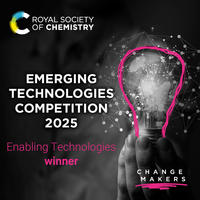Prof Graham Hutchings CBE FREng FRS and team wins at RSC Emerging Technologies Competition
SCHEMA Co-Investigator Prof Graham Hutchings CBE FREng FRS and the team at the Cardiff Catalysis Institute were recently announced as the winners of the Enabling Technologies Category of the Royal Society of Chemistry Emerging Technologies Competition 2025.
The Cardiff Catalysis Institute’s Hydro-Oxy technology is a new innovative catalytic route that decouples chemical synthesis from industrial hydrogen peroxide production. Generating hydrogen peroxide in-situ, it achieves significant improvements in process intensification, safety and efficiency, reducing environmental impact and lowering manufacturing costs, whilst rivalling the performance metrics of the state-of-the-art industrial processes.
With nearly 2.5 million tons of H2O2 utilised in feedstock upgrading every year a long-standing goal of catalysis has been replacing preformed H2O2 with that generated in-situ for chemical synthesis. However, until now, a combination of catalyst deactivation, poor selectivities and low yields, has prevented the adoption of such approaches.
Focusing on the production of cyclohexanone oxime (a key precursor to Nylon-6 (9 milliontons/annum, market size of $9 billion)), this technology has, for the first time, decoupled the production of a major commodity chemical from the use of costly and carbon-intensive, commercial H2O2. This was achieved through the development of a series of bifunctional catalysts composed of Pd-based nanoparticles immobilised on a titanosilicate support, which can both synthesise H2O2 in-situ, from dilute streams of the elements and subsequently utilise H2O2 in oxime production.
The in-situ approach rivals the performance of the state-of-the-art industrial technology, which is reliant on preformed H2O2, achieving (1) yields approaching 100%, (2) near total selective utilisation of key feedstocks and (3) excellent substrate scope.
A detailed techno-economic analysis estimates that the in-situ approach would achieve an approximate 15 % cost saving (based on reagents alone) compared to leading industrial technology, which translates to a saving of $300/tonoxime. Importantly, this technology can be readily incorporated into existing commercial reactors, further minimising barriers to industrial adoption. The in-situ approach to chemical production would considerably lower manufacturing costs and reduce GHG emissions, avoiding the high energy demand (approx. 740 kWh/tH2O2) and cooling water requirements (approx. 200 tH2O/tH2O2) associated with commercial H2O2 production. Indeed the team estimate that their technology would lower energy demands and CO2 emissions associated with oxime synthesis by 30%, .
Project lead Dr Richard Lewis, based at the Max Planck–Cardiff Centre on the Fundamentals of Heterogeneous Catalysis, said:
"For industrial chemical production to be fit for the 21st Century there is a need for alternative technologies which ensure the efficient use of finite resources. Catalysis, which contributes approximately 35 % to global GDP and is involved in the production of over 80 % of manufactured goods, is uniquely situated to meet these challenges."
"We are delighted our work has been recognised by the RSC Emerging Technologies Prize Committee for its potential to precipitate a sea-change in industrial oxidation chemistry. The adoption of this technology paves the way for cleaner, more efficient chemical production by generating H2O2 where it is needed and is positive step towards more sustainable chemical sector."
"We are excited to continue to work with existing and new partners to drive this technology towards industrial application for the production of a range of global chemicals."
Read the RSC news item or watch the interview with Dr Richard Lewis
In addition to recognition by the RSC Emerging Technologies Committee, the team have previously been named winners of the RSC Environment, Sustainability & Energy Prize Committee (2024) and were highly commended by the Institution of Chemical Engineers at the 2023 IChemE Global Awards. Their technology has been considered ‘a breakthrough in the chemical scientific world’ by experts in the field (doi.org/10.1016/j.chempr.2022.05.006).




